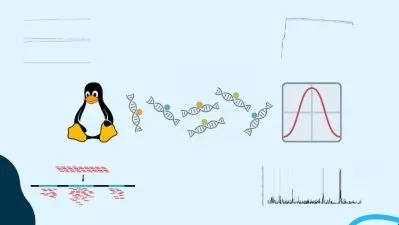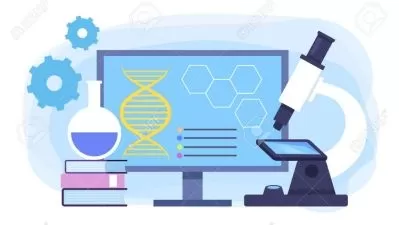Updated Comprehensive Guide to Bioinformatics Databases
Abdul Rehman Ikram
1:45:17
Description
in and out guide to best bioinformatics databases out there being used now a days from basic to specified like genome
What You'll Learn?
- You will gain complete understanding on Bioinformatics Databases. From basic to advance concepts.
- After this practical course you will confidently choose database according to your research need without any doubts.
- Different databases used in bioinformatics
- They will be able to use and know different categories of sub-databases of NCBI.
- Plant and Genome Databases
- Primary Databases in Bioinformatics
- Secondary Databases in Bioinformatics
- After this course Students will have intermediate Knowledge of UCSC Genome Browser in Bioinformatics.
- Students will be able to use different tools for Sequence Analysis and will know different categories of sub-databases.
- Students will be able to use different tools of UCSC for Genome Analysis.
- Students will be Able to perform Genome analysis on any gene
- Tools Used in Plant Databases
- They will be able to use and know different categories of sub-databases of Plant Databases.
- Top ten databases being used in plant bioinformatics
- Different Plant databases used in bioinformatics
- Complete up-to Date Beginner's Guide of top Plant Databases Used in Bioinformatics along with their utilization
- You will gain concrete diffrences between Primary, Seconday and Composite database. The knowledge will help you to choose curated and reviewed data.
Who is this for?
What You Need to Know?
More details
DescriptionBioinformatics is an interdisciplinary field that combines biology, computer science, and information technology to analyze, manage, and interpret biological data. It involves the use of computational tools and techniques to store, retrieve, analyze, and predict the composition and structure of biomolecules, such as DNA, RNA, and proteins.
The main aims of bioinformatics include:
1. Development of comprehensive databases: Bioinformatics aims to create databases that contain all relevant biological information, making it easily accessible for research and analysis.
2. Improvement of data analysis tools: Bioinformatics seeks to enhance the tools used for data organization, annotation, and mining. This includes developing algorithms and software for tasks such as sequence analysis, protein structure prediction, and docking analysis.
3. Drug discovery and development: Bioinformatics plays a crucial role in the design and development of drugs. It utilizes simulation software to model and predict the interactions between drugs and biomolecules, facilitating the discovery of potential drug candidates.
4. Function prediction and annotation: Bioinformatics tools are used to predict the function of genes and proteins based on their sequence and structural characteristics. This helps in understanding the role of specific biomolecules in biological processes.
5. Sequence analysis and similarity search: Bioinformatics tools enable the analysis of biological sequences, such as DNA and protein sequences, to identify similarities, functional motifs, and evolutionary relationships.
Biological databases are essential in bioinformatics, as they provide a structured and organized repository of biological data. These databases store various types of information, including DNA and protein sequences, gene annotations, protein structures, metabolic pathways, and more. They allow researchers to retrieve, analyze, and compare biological data efficiently.
The UCSC Genome Browser is a widely used primary database browser in bioinformatics. It provides an interactive website for accessing and visualizing genome sequence data from various species, along with annotated tracks that include gene information. The UCSC Genome Browser allows researchers to explore and analyze genomic data at different scales and provides valuable insights into gene structure, regulation, and function.
In this course, you will gain a deep understanding of the UCSC Genome Browser and its applications. The focus will be on exploring the SARS-COV-2 genome as a case study. Additionally, the Table Browser, a tool within the UCSC Genome Browser, will be covered, which allows for the calculation of intersections between tracks and retrieval of DNA sequences.
The course will be divided into three parts: Introduction, Explanation, and Summary, ensuring that the content is presented in a comprehensive and accessible manner. This course is particularly beneficial for students and bioinformaticians who frequently work with biological databases and seek to enhance their skills in utilizing the UCSC Genome Browser.
Feel free to reach out to the instructor for any questions or suggestions. Your queries will be addressed within 12 hours. Get ready to explore the fascinating world of bioinformatics and the power of the UCSC Genome Browser!
Who this course is for:
- Data Scientist are Encouraged to take this course
- Researchers are also encouraged to take this Course
Bioinformatics is an interdisciplinary field that combines biology, computer science, and information technology to analyze, manage, and interpret biological data. It involves the use of computational tools and techniques to store, retrieve, analyze, and predict the composition and structure of biomolecules, such as DNA, RNA, and proteins.
The main aims of bioinformatics include:
1. Development of comprehensive databases: Bioinformatics aims to create databases that contain all relevant biological information, making it easily accessible for research and analysis.
2. Improvement of data analysis tools: Bioinformatics seeks to enhance the tools used for data organization, annotation, and mining. This includes developing algorithms and software for tasks such as sequence analysis, protein structure prediction, and docking analysis.
3. Drug discovery and development: Bioinformatics plays a crucial role in the design and development of drugs. It utilizes simulation software to model and predict the interactions between drugs and biomolecules, facilitating the discovery of potential drug candidates.
4. Function prediction and annotation: Bioinformatics tools are used to predict the function of genes and proteins based on their sequence and structural characteristics. This helps in understanding the role of specific biomolecules in biological processes.
5. Sequence analysis and similarity search: Bioinformatics tools enable the analysis of biological sequences, such as DNA and protein sequences, to identify similarities, functional motifs, and evolutionary relationships.
Biological databases are essential in bioinformatics, as they provide a structured and organized repository of biological data. These databases store various types of information, including DNA and protein sequences, gene annotations, protein structures, metabolic pathways, and more. They allow researchers to retrieve, analyze, and compare biological data efficiently.
The UCSC Genome Browser is a widely used primary database browser in bioinformatics. It provides an interactive website for accessing and visualizing genome sequence data from various species, along with annotated tracks that include gene information. The UCSC Genome Browser allows researchers to explore and analyze genomic data at different scales and provides valuable insights into gene structure, regulation, and function.
In this course, you will gain a deep understanding of the UCSC Genome Browser and its applications. The focus will be on exploring the SARS-COV-2 genome as a case study. Additionally, the Table Browser, a tool within the UCSC Genome Browser, will be covered, which allows for the calculation of intersections between tracks and retrieval of DNA sequences.
The course will be divided into three parts: Introduction, Explanation, and Summary, ensuring that the content is presented in a comprehensive and accessible manner. This course is particularly beneficial for students and bioinformaticians who frequently work with biological databases and seek to enhance their skills in utilizing the UCSC Genome Browser.
Feel free to reach out to the instructor for any questions or suggestions. Your queries will be addressed within 12 hours. Get ready to explore the fascinating world of bioinformatics and the power of the UCSC Genome Browser!
Who this course is for:
- Data Scientist are Encouraged to take this course
- Researchers are also encouraged to take this Course
User Reviews
Rating
Abdul Rehman Ikram
Instructor's Courses
Udemy
View courses Udemy- language english
- Training sessions 41
- duration 1:45:17
- English subtitles has
- Release Date 2024/04/13











